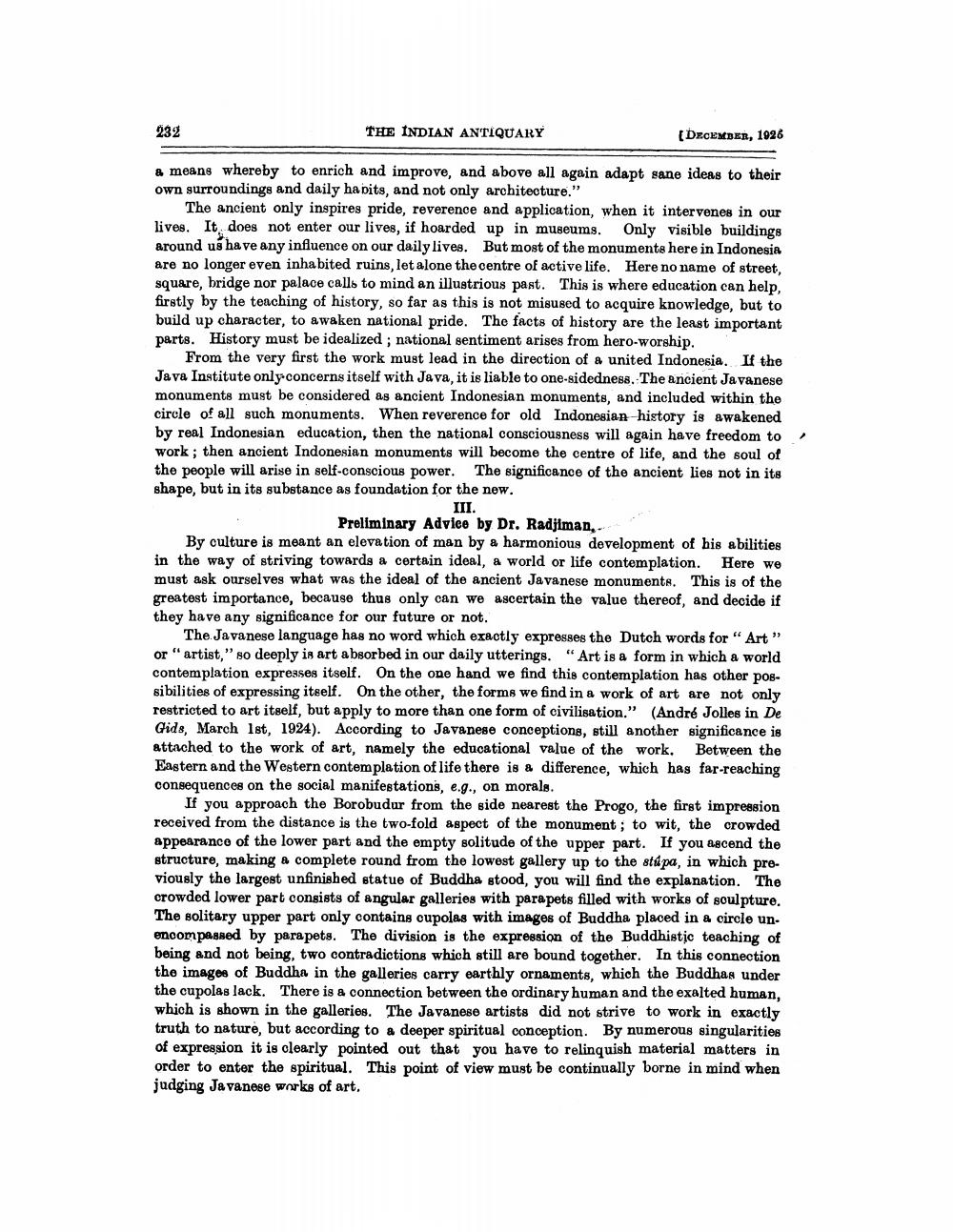________________
232
THE INDIAN ANTIQUARY
[DECEMBER, 1926
a means whereby to enrich and improve, and above all again adapt sane ideas to their own surroundings and daily habits, and not only architecture."
The ancient only inspires pride, reverence and application, when it intervenes in our lives. It does not enter our lives, if hoarded up in museums. Only visible buildings around us have any influence on our daily lives. But most of the monuments here in Indonesia are no longer even inhabited ruins, let alone the centre of active life. Here no name of street, square, bridge nor palace calls to mind an illustrious past. This is where education can help, firstly by the teaching of history, so far as this is not misused to acquire knowledge, but to build up character, to awaken national pride. The facts of history are the least important parts. History must be idealized; national sentiment arises from hero-worship.
From the very first the work must lead in the direction of a united Indonesia. If the Java Institute only concerns itself with Java, it is liable to one-sidedness. The ancient Javanese monuments must be considered as ancient Indonesian monuments, and included within the circle of all such monuments. When reverence for old Indonesian history is awakened by real Indonesian education, then the national consciousness will again have freedom to work; then ancient Indonesian monuments will become the centre of life, and the soul of the people will arise in self-conscious power. The significance of the ancient lies not in its shape, but in its substance as foundation for the new.
III.
Preliminary Advice by Dr. Radjiman,
By culture is meant an elevation of man by a harmonious development of his abilities in the way of striving towards a certain ideal, a world or life contemplation. Here we must ask ourselves what was the ideal of the ancient Javanese monuments. This is of the greatest importance, because thus only can we ascertain the value thereof, and decide if they have any significance for our future or not.
The Javanese language has no word which exactly expresses the Dutch words for "Art" or "artist," so deeply is art absorbed in our daily utterings. "Art is a form in which a world contemplation expresses itself. On the one hand we find this contemplation has other possibilities of expressing itself. On the other, the forms we find in a work of art are not only restricted to art itself, but apply to more than one form of civilisation." (André Jolles in De Gids, March 1st, 1924). According to Javanese conceptions, still another significance is attached to the work of art, namely the educational value of the work. Between the Eastern and the Western contemplation of life there is a difference, which has far-reaching consequences on the social manifestations, e.g., on morals.
If you approach the Borobudur from the side nearest the Progo, the first impression received from the distance is the two-fold aspect of the monument; to wit, the crowded appearance of the lower part and the empty solitude of the upper part. If you ascend the structure, making a complete round from the lowest gallery up to the stúpa, in which previously the largest unfinished statue of Buddha stood, you will find the explanation. The crowded lower part consists of angular galleries with parapets filled with works of soulpture. The solitary upper part only contains cupolas with images of Buddha placed in a circle unencompassed by parapets. The division is the expression of the Buddhistic teaching of being and not being, two contradictions which still are bound together. In this connection the images of Buddha in the galleries carry earthly ornaments, which the Buddhas under the cupolas lack. There is a connection between the ordinary human and the exalted human, which is shown in the galleries. The Javanese artists did not strive to work in exactly truth to nature, but according to a deeper spiritual conception. By numerous singularities of expression it is clearly pointed out that you have to relinquish material matters in order to enter the spiritual. This point of view must be continually borne in mind when judging Javanese works of art.




